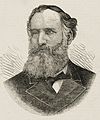
Sir George Richard Dibbs KCMG was an Australian politician who was Premier of New South Wales on three occasions.
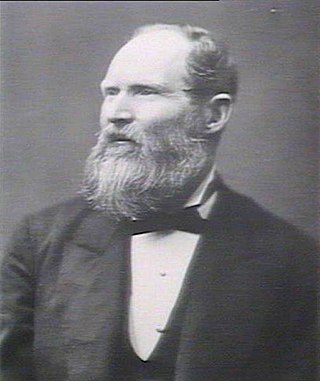
James Squire Farnell was an Australian politician and Premier of New South Wales. Farnell was a hard-working legislator who gave much study to the land question and also tried hard for some years to pass a bill for the regulation of contagious diseases.
Members of the New South Wales Legislative Assembly who served in the 11th parliament of New South Wales held their seats from 1882 to 1885. Elections for the eleventh Legislative Assembly were held between 30 November and 21 December 1882 with parliament first meeting on 3 January 1883. The Assembly was expanded to 113 members elected in 40 single member electorates, 26 two member electorates, 3 three member electorate and 3 four member electorates. The parliament had a maximum term of 3 years and was dissolved on 7 October 1885 after 33 months. The Premiers during this parliament were Sir Alexander Stuart until 7 October 1885 and then George Dibbs. The Speaker was Edmund Barton.

The Stuart ministry was the 20th ministry of the Colony of New South Wales, and was led by Sir Alexander Stuart. Stuart was elected to the New South Wales Legislative Assembly in 1874.
The first Dibbs ministry was the 21st ministry of the Colony of New South Wales, and was the first of three occasions of being led by the Premier, George Dibbs. Dibbs was elected to the New South Wales Legislative Assembly in 1874.
The fourth Parkes ministry was the 24th ministry of the Colony of New South Wales, and was led by the seventh Premier, Sir Henry Parkes. It was the fourth of five occasions that Parkes was Premier.

The fifth Parkes ministry was the 26th ministry of the Colony of New South Wales, and was led by the seventh Premier, Sir Henry Parkes. It was the fifth and final occasion that Parkes was Premier. The title of Premier was widely used to refer to the Leader of Government, but was not a formal position in the government until 1920. Instead the Premier was appointed to another portfolio, usually Colonial Secretary. Having served in the New South Wales Legislative Council between 1854 and 1856, Parkes was elected in the first free elections for the New South Wales Legislative Assembly held in 1856, however resigned from Parliament later that year. He served in the Assembly on several occasions, between 1858 and 1870, being forced to resign on 4 occasions due to his personal insolvency. He came to power as Premier on the first occasion in 1872, serving as Premier for a period of three years. However, Parkes lost the confidence of the Assembly following Governor Robinson's decision to release of the bushranger Frank Gardiner led to the defeat of the ministry in 1875.

The second Dibbs ministry was the 25th ministry of the Colony of New South Wales, and was the second of three occasions of being led by the tenth Premier, George Dibbs. Dibbs was elected to the New South Wales Legislative Assembly in 1874. In a period of great financial stress for the Colony, this ministry covers just 49 days from 17 January 1889 until 7 March 1889. Dibbs took over as Premier on the first occasion in October 1885 following resignation of the Alexander Stuart due to ill-health, with his ministry lasting for 75 days. Dibbs served as Colonial Secretary in the Jennings ministry, before it too suffered budgetary pressures. It was during this time that the party system was formed in New South Wales with Sir Henry Parkes leading the Free Trade Party. Dibbs had been elected as an independent free trader, however his opposition to Parkes caused Dibbs to align himself with the Protectionist Party. Dibbs had assumed office when Parkes lost a vote on the floor of the Assembly. Parliament was dissolved on 19 January 1889 and an election was held in February. There was a significant swing to the Protectionists, gaining 29 seats, however it was insufficient to command a majority of the Legislative Assembly and Parkes resumed the premiership.
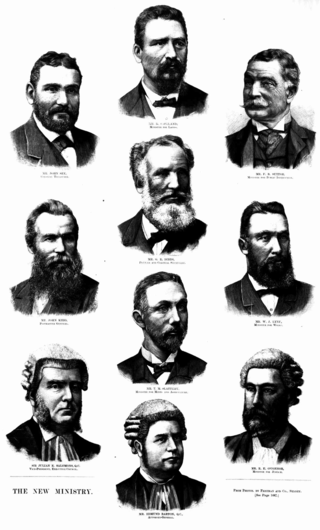
The third Dibbs ministry, the 27th ministry of the Colony of New South Wales, was led by Sir George Dibbs, leader of the Protectionist Party, following the 1891 New South Wales election, which saw the Labour Party win seats in the New South Wales Legislative Assembly and the balance of power. With no party having a majority, Sir Henry Parkes held on as Premier until October 1891 when he lost a vote in the Legislative Assembly, causing Parkes to resign as Premier and leader of the Free Trade Party. Dibbs formed the ministry on 23 October 1891, with Labour support, and comprised 10 ministers.
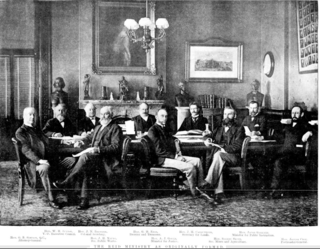
The Reid ministry was the 28th ministry of the Colony of New South Wales, and was led by the 12th Premier, George Reid. The title of Premier was widely used to refer to the Leader of Government, but was not a formal position in the government until 1920. Instead the Premier was appointed to another portfolio, usually Colonial Secretary but on this occasion Reid took the portfolio of Colonial Treasurer until July 1899 and then Attorney General.
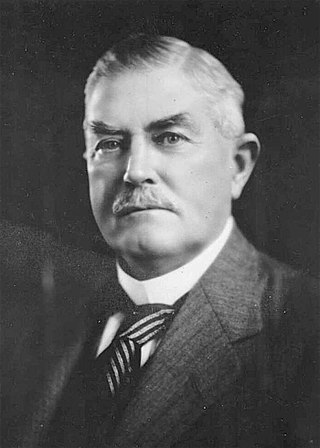
The 1922 New South Wales state election was held on 25 March 1922. This election was for all of the 90 seats in the 26th New South Wales Legislative Assembly and it was conducted in multiple member constituencies using the Hare Clark single transferable vote. The 25th parliament of New South Wales was dissolved on 17 February 1922 by the Governor, Sir Walter Edward Davidson, on the advice of the Premier James Dooley.

The 1891 New South Wales colonial election was held in the then colony of New South Wales between 17 June to 3 July 1891. This election was for all of the 141 seats in the New South Wales Legislative Assembly and it was conducted in 35 single-member constituencies, 20 2-member constituencies, 10 3-member constituencies and nine 4-member constituencies, all with a first past the post system. Part 1 of the Electoral Act of 1880 set the qualification for election on "every male subject of Her Majesty of the full age of twenty-one years and absolutely free being a natural born or naturalized subject". Seven seats were uncontested. The previous parliament of New South Wales was dissolved on 6 June 1891 by the Governor, The Earl of Jersey, on the advice of the Premier, Sir Henry Parkes.

The 1894 New South Wales colonial election was held on 17 July 1894 for all of the 125 seats in the 16th New South Wales Legislative Assembly and it was conducted in single-member constituencies with a first past the post voting system. Section 23 (1) of the Parliamentary Electorates and Elections Act of 1893 conferred a right to vote on 'every male person, being a natural born [British] subject, who shall have resided or had his principal place of abode in New South Wales for a continuous period of one year'. The 15th parliament of New South Wales was dissolved on 25 June 1894 by the Governor, Sir Robert Duff, on the advice of the Premier, George Dibbs.

The 1889 New South Wales colonial election was held between 1 February and 16 February 1889. This election was for all of the 137 seats in the New South Wales Legislative Assembly and it was conducted in 37 single-member constituencies, nineteen 2-member constituencies, ten 3-member constituencies and eight 4-member constituencies, all with a first past the post system. Part 1 of the Electoral Act of 1880 had awarded the right to vote to 'every male subject of Her Majesty of the full age of twenty-one years and absolutely free being a natural born or naturalized'. The previous parliament of New South Wales was dissolved on 19 January 1889 by the Governor, Lord Carrington, on the advice of the Premier, George Dibbs.
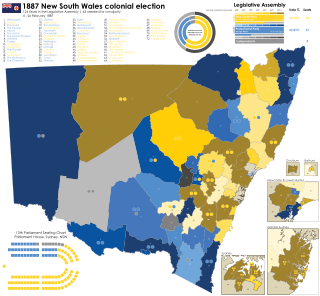
The 1887 New South Wales colonial election was held between 4 February and 26 February 1887. This election was for all of the 124 seats in the New South Wales Legislative Assembly and it was conducted in 37 single-member constituencies, 23 2-member constituencies, seven 3-member constituencies and five 4-member constituencies, all with a first past the post system. Part 1 of the Electoral Act of 1880 had awarded the right to vote to 'every male subject of Her Majesty of the full age of twenty-one years and absolutely free being a natural born or naturalized'. The previous parliament of New South Wales was dissolved on 26 January 1887 by the Governor, Lord Carrington, on the advice of the Premier, Sir Henry Parkes.
The 1882 New South Wales colonial election was held between 30 November and 21 December 1882. This election was for all of the 113 seats in the New South Wales Legislative Assembly and it was conducted in 40 single-member constituencies, 26 2-member constituencies, three 3-member constituencies and three 4-member constituencies, all with a first past the post system. Suffrage was limited to adult male British subjects, resident in New South Wales. The previous parliament of New South Wales was dissolved on 23 November 1882 by the Governor, Lord Augustus Loftus, on the advice of the Premier, Sir Henry Parkes.
The 1880 New South Wales colonial election was held between 17 November and 2 December 1880. This election was for all of the 108 seats in the New South Wales Legislative Assembly and it was conducted in 43 single-member constituencies, 25 2-member constituencies, one 3-member constituency and three 4-member constituencies, all with a first past the post system. Suffrage was limited to adult white males. The previous parliament of New South Wales was dissolved on 9 November 1880 by the Governor, Lord Augustus Loftus, on the advice of the Premier, Sir Henry Parkes.
The 1877 New South Wales colonial election was held between 24 October and 12 November 1877. This election was for all of the 73 seats in the New South Wales Legislative Assembly and it was conducted in 53 single-member constituencies, six 2-member constituencies and two 4-member constituencies, all with a first past the post system. Suffrage was limited to adult male British subjects, resident in New South Wales. The previous parliament of New South Wales was dissolved on 12 October 1877 by the Governor, Sir Hercules Robinson, on the advice of the Premier, Sir John Robertson.
The 1858 New South Wales colonial election was held between 13 January and 12 February 1858. This election was for all of the 54 seats in the New South Wales Legislative Assembly and it was conducted in 18 single-member constituencies, 13 2-member constituencies, two 3-member constituencies and one 4-member constituency, all with a first past the post system. Suffrage was limited to adult white males. The previous parliament of New South Wales was dissolved on 19 December 1857 by the Governor, Sir William Denison, on the advice of the Premier, Charles Cowper.
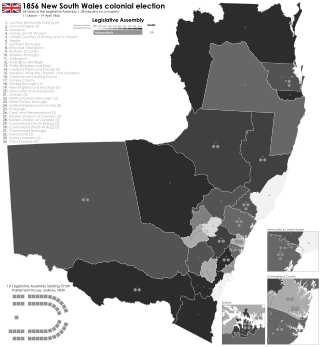
The 1856 New South Wales colonial election was held between 11 March and 19 April 1856. This election was for all of the 54 seats in the New South Wales Legislative Assembly and it was conducted in 18 single-member constituencies, 13 2-member constituencies, two 3-member constituencies and one 4-member constituency, all with a first past the post system.

